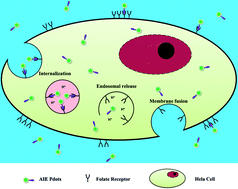Folic acid-functionalized AIE Pdots based on amphiphilic PCL-b-PEG for targeted cell imaging†
Abstract
Fluorescent block amphiphilic copolymers are one of the most important bioimaging materials which are highly desirable for early stage cancer diagnosis and treatment. However, sometimes the application of the fluorescent block copolymers is severely limited because of the aggregation-caused quenching (ACQ) effect. In this study, new aggregation induced emission polymer dots (AIE Pdots) were prepared through a self-assembly process by using an AIE-conjugated block copolymer containing an AIE fluorophore, 9,10-bis(4-hydroxystyryl)anthracene, hydrophobic poly(ε-caprolactone) segments, hydrophilic poly(ethylene glycol) segments and folate groups. The AIE Pdots are monodispersed in H2O with an average diameter of 15 nm, and possess strong emission and high solid state fluorescence quantum efficiency (Φ = 27.0%). Furthermore, the AIE Pdots show good stability and little toxicity to living cells and thus can be utilized for targeted HeLa cell imaging. Biological imaging investigation indicated that the folic acid functionalized AIE Pdots can be applied for targeted HeLa intracellular imaging.


 Please wait while we load your content...
Please wait while we load your content...